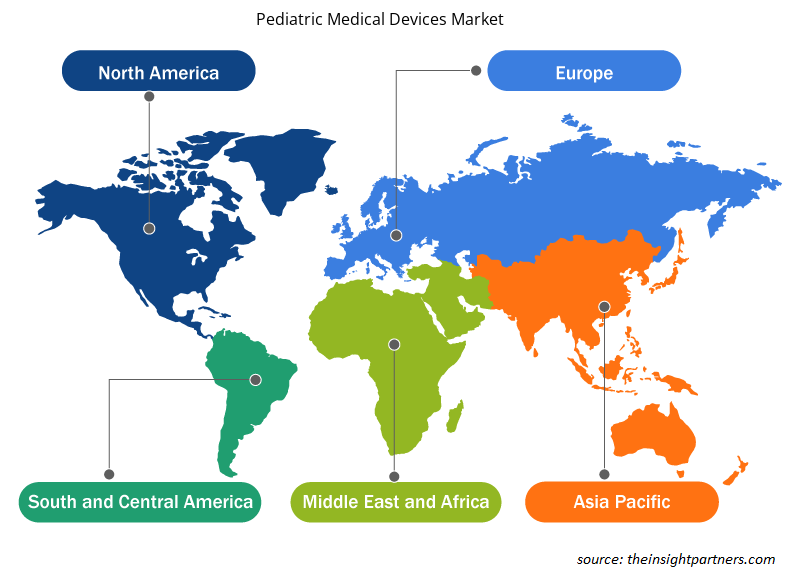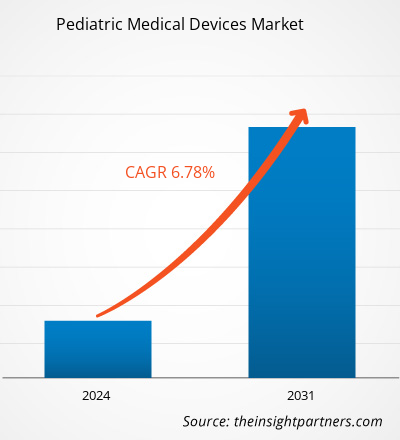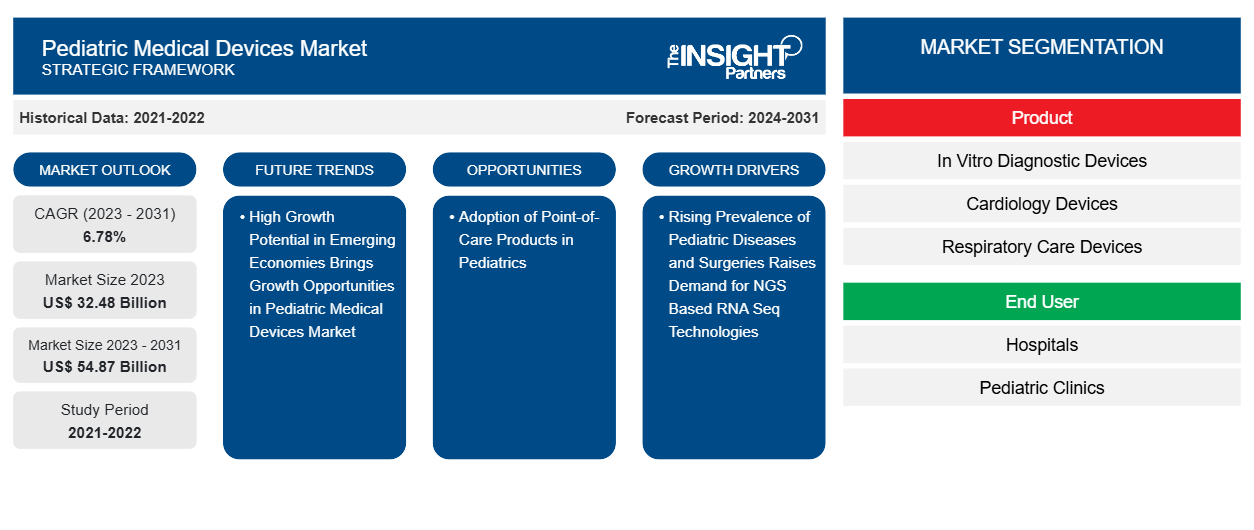La taille du marché des dispositifs médicaux pédiatriques devrait atteindre 54,87 milliards USD d'ici 2031, contre 32,48 milliards USD en 2023. Le marché devrait enregistrer un TCAC de 6,78 % au cours de la période 2023-2031. La popularité croissante des dispositifs Point-of-Care pour les soins pédiatriques devrait rester l'une des principales tendances du marché.
Analyse du marché des dispositifs médicaux pédiatriques
Les dispositifs médicaux pédiatriques traitent ou diagnostiquent des pathologies chez les individus de la naissance à 21 ans. Les patients pédiatriques sont définis comme des personnes âgées de 21 ans ou moins au moment de leur diagnostic ou de leur traitement. Les sous-populations pédiatriques sont classées comme les nouveau-nés (de la naissance à 28 jours), les nourrissons (de 29 jours à moins de 2 ans), les enfants (de 2 ans à moins de 12 ans) et les adolescents (de 12 à 21 ans). L'augmentation des maladies chroniques au sein de la population pédiatrique accroît la demande de dispositifs médicaux pédiatriques.
Aperçu du marché des dispositifs médicaux pédiatriques
Selon un article publié dans la bibliothèque en ligne Wiley en août 2020, 3,9 millions d’interventions chirurgicales sont pratiquées chaque année sur des enfants âgés de 0 à 17 ans aux États-Unis. Les interventions chirurgicales les plus courantes chez les enfants, à l’exception de la circoncision, sont liées à l’oreille, au nez et à la gorge : amygdalectomies, adénoïdectomies et pose de tubes de tympanostomie. Le nombre croissant d’interventions chirurgicales pédiatriques accroît la demande d’innovations sur le marché des dispositifs médicaux pédiatriques. De plus, face à la demande croissante, les entreprises introduisent de nouvelles technologies pour accélérer la croissance de leur part de marché. Par exemple, en juin 2021, Preceptis Medical, Inc. a lancé Hummingbird Tympanostomie Tube System (TTS), un système de tube auriculaire de nouvelle génération pour les procédures de myringotomie pédiatrique en cabinet. Le nouveau dispositif Hummingbird présente une conception ergonomique améliorée qui rend les procédures de tympanostomie chez les tout-petits plus réussies sans anesthésie générale.
Personnalisez ce rapport en fonction de vos besoins
Vous bénéficierez d'une personnalisation gratuite de n'importe quel rapport, y compris de certaines parties de ce rapport, d'une analyse au niveau des pays, d'un pack de données Excel, ainsi que d'offres et de remises exceptionnelles pour les start-ups et les universités.
- Obtenez les principales tendances clés du marché de ce rapport.Cet échantillon GRATUIT comprendra une analyse de données, allant des tendances du marché aux estimations et prévisions.
Moteurs et opportunités du marché des dispositifs médicaux pédiatriques
Le nombre croissant d'interventions chirurgicales pédiatriques favorise le marché
Comme le souligne le Fonds des Nations Unies pour l'enfance (UNICEF), la pneumonie est la principale cause de décès chez les enfants de moins de 5 ans, entraînant environ 700 000 décès par an. La prévalence croissante des maladies chroniques, notamment des maladies respiratoires, du cancer et des troubles cardiovasculaires, devrait stimuler la demande de dispositifs médicaux pédiatriques. L'encéphalopathie hypoxique-ischémique (EHI) est l'une des principales causes de mortalité et de morbidité néonatales chez les nourrissons nés à terme et presque à terme. Grâce aux progrès des soins néonatals, les technologies médicales ont permis l'adoption de nouvelles thérapies pour soutenir les soins ou être explorées dans le cadre d'études cliniques à grande échelle. En conséquence, l'adoption croissante de dispositifs médicaux dans les établissements de soins pédiatriques alimente le marché mondial des dispositifs médicaux pédiatriques.Hypoxic-Ischemic Encephalopathy (HIE) is a leading cause of neonatal mortality and morbidity in term and near-term infants. With the advancements in neonatal care,
Le potentiel de croissance élevé des économies émergentes offre des opportunités de croissance
Selon un article publié dans BMJ Open en novembre 2022, une étude menée à partir des données de l'enquête démographique et de santé de 33 pays d'Afrique subsaharienne a conclu que les maladies infantiles courantes sont répandues chez les enfants de moins de 5 ans dans les pays d'Afrique subsaharienne. Des facteurs aux niveaux individuel et communautaire sont associés à ce problème. En outre, l'expansion des infrastructures de santé dans les économies émergentes et l'importance croissante accordée à la télémédecine offrent des perspectives prometteuses d'expansion du marché. Ainsi, les initiatives collectives des organisations internationales, telles que l'OMS et l'UNICEF dans les régions telles que l'Asie-Pacifique, le Moyen-Orient et l'Afrique, renforcent leurs infrastructures de soins de santé pédiatriques en sensibilisant à la sécurité pédiatrique. Celles-ci sont susceptibles d'offrir des opportunités lucratives pour la croissance du marché des dispositifs médicaux pédiatriques au cours de la période de prévision.BMJ Open in November 2022, a study conducted using Demographic and Health Survey data from 33 sub-Saharan African countries concluded that Common childhood illnesses are prevalent among under-5 children in sub-Saharan African countries. Factors at individual and community levels are associated with this issue. Furthermore, the expanding healthcare infrastructure in emerging economies and the growing emphasis on telemedicine offer promising prospects for market expansion. Thus, collective initiatives by the international organizations, such as WHO and UNICEF in the regions such as the Asia Pacific, and Middle East and Africa strengthen their pediatric healthcare infrastructures by creating awareness regarding pediatric safety. These are likely to offer lucrative opportunities for the pediatric medical devices market growth during the forecast period.
Analyse de segmentation du rapport sur le marché des dispositifs médicaux pédiatriques
Les segments clés qui ont contribué à l’élaboration de l’analyse du marché des dispositifs médicaux pédiatriques sont le produit et l’utilisateur final.
- Le marché des dispositifs médicaux pédiatriques est segmenté en fonction du produit en dispositifs de diagnostic in vitro (DIV), dispositifs de cardiologie, dispositifs de soins respiratoires, dispositifs de surveillance, dispositifs de soins intensifs néonatals et autres. Le segment des dispositifs de diagnostic in vitro (DIV) détenait la plus grande part de marché en 2023.vitro diagnostic (IVD) devices, cardiology devices, respiratory care devices, monitoring devices, neonatal ICU devices, and others. The in vitro diagnostic (IVD) devices segment held the largest market share in 2023.
- En fonction de l'utilisateur final, le marché est segmenté en hôpitaux, cliniques pédiatriques et autres. Le segment des hôpitaux détenait la plus grande part du marché en 2023.
Analyse des parts de marché des dispositifs médicaux pédiatriques par zone géographique
La portée géographique du rapport sur le marché des dispositifs médicaux pédiatriques est principalement divisée en cinq régions : Amérique du Nord, Asie-Pacifique, Europe, Moyen-Orient et Afrique, et Amérique du Sud et centrale. L'Asie-Pacifique devrait connaître le TCAC le plus élevé dans les années à venir.CAGR in the coming years.
Le marché des dispositifs médicaux pédiatriques en Amérique du Nord est analysé en fonction des trois principaux pays : les États-Unis, le Canada et le Mexique. Les États-Unis devraient détenir la plus grande part du marché nord-américain des dispositifs médicaux pédiatriques en 2023.
Selon l'Académie américaine de pédiatrie, environ 3 à 4 % des bébés nés aux États-Unis présentent des anomalies congénitales. Selon les Centres pour le contrôle et la prévention des maladies (CDC), 1 bébé sur 33 né aux États-Unis est affecté par des malformations congénitales chaque année. L'augmentation du nombre de populations pédiatriques présentant des malformations congénitales reflète le nombre croissant de populations soumises à des traitements chirurgicaux. Par conséquent, des facteurs tels que le fardeau croissant des maladies pédiatriques, les activités de recherche et développement pour développer des dispositifs médicaux pédiatriques avancés et l'augmentation des lancements de produits contribuent à la croissance de la part de marché des dispositifs médicaux pédiatriques aux États-Unis.
Aperçu régional du marché des dispositifs médicaux pédiatriques
Les tendances régionales et les facteurs influençant le marché des dispositifs médicaux pédiatriques tout au long de la période de prévision ont été expliqués en détail par les analystes d’Insight Partners. Cette section traite également des segments et de la géographie du marché des dispositifs médicaux pédiatriques en Amérique du Nord, en Europe, en Asie-Pacifique, au Moyen-Orient et en Afrique, ainsi qu’en Amérique du Sud et en Amérique centrale.

- Obtenez les données régionales spécifiques au marché des dispositifs médicaux pédiatriques
Portée du rapport sur le marché des dispositifs médicaux pédiatriques
| Attribut de rapport | Détails |
|---|---|
| Taille du marché en 2023 | 32,48 milliards de dollars américains |
| Taille du marché d'ici 2031 | 54,87 milliards de dollars américains |
| Taux de croissance annuel composé mondial (2023-2031) | 6,78% |
| Données historiques | 2021-2022 |
| Période de prévision | 2024-2031 |
| Segments couverts | Par produit
|
| Régions et pays couverts | Amérique du Nord
|
| Leaders du marché et profils d'entreprises clés |
|
Densité des acteurs du marché des dispositifs médicaux pédiatriques : comprendre son impact sur la dynamique commerciale
Le marché des dispositifs médicaux pédiatriques connaît une croissance rapide, tirée par la demande croissante des utilisateurs finaux en raison de facteurs tels que l'évolution des préférences des consommateurs, les avancées technologiques et une plus grande sensibilisation aux avantages du produit. À mesure que la demande augmente, les entreprises élargissent leurs offres, innovent pour répondre aux besoins des consommateurs et capitalisent sur les tendances émergentes, ce qui alimente davantage la croissance du marché.
La densité des acteurs du marché fait référence à la répartition des entreprises ou des sociétés opérant sur un marché ou un secteur particulier. Elle indique le nombre de concurrents (acteurs du marché) présents sur un marché donné par rapport à sa taille ou à sa valeur marchande totale.
Les principales entreprises opérant sur le marché des dispositifs médicaux pédiatriques sont :
- F. Hoffmann-La Roche SARL
- Compagnie Générale d'Électricité
- Atom Medical Corp.
- Royal Philips NV
- Siemens AG
- Medtronic
Avis de non-responsabilité : les sociétés répertoriées ci-dessus ne sont pas classées dans un ordre particulier.

- Obtenez un aperçu des principaux acteurs du marché des dispositifs médicaux pédiatriques
Actualités et développements récents du marché des dispositifs médicaux pédiatriques
Le marché des dispositifs médicaux pédiatriques est évalué en collectant des données qualitatives et quantitatives issues de recherches primaires et secondaires, qui comprennent des publications d'entreprise essentielles, des données d'association et des bases de données. Quelques-uns des développements du marché des dispositifs médicaux pédiatriques sont répertoriés ci-dessous :
- OrthoPediatrics Corp. a conclu un accord pour acquérir Pega Medical, notamment son système intramédullaire télescopique Fassier-Duval conçu pour les patients souffrant d'ostéogenèse imparfaite et d'autres déformations osseuses. Leur offre de produits comprend de nouvelles technologies pour traiter certaines des pathologies les plus spécifiques de l'orthopédie pédiatrique. (Source : OrthoPediatrics Corp, communiqué de presse, juin 2022).
- LMT Medical Systems a créé le « Nomag IC Enhanced », un incubateur de diagnostic IRM avancé qui permet aux nouveau-nés et aux bébés prématurés d'être transférés directement de l'unité de soins intensifs néonatals vers la salle d'IRM pour y être testés à l'aide d'une imagerie par résonance magnétique optimale et non invasive. Tout au long du transport et de l'examen IRM, le nourrisson est protégé à l'intérieur de l'incubateur IRM à température et humidité contrôlées, qui lui permet de survivre. (Source : Ergotron, communiqué de presse, décembre 2020).
Rapport sur le marché des dispositifs médicaux pédiatriques : couverture et livrables
Le rapport « Taille et prévisions du marché des dispositifs médicaux pédiatriques (2021-2031) » fournit une analyse détaillée du marché couvrant les domaines ci-dessous :
- Taille et prévisions du marché des dispositifs médicaux pédiatriques aux niveaux mondial, régional et national pour tous les segments de marché clés couverts par le périmètre
- Tendances du marché des dispositifs médicaux pédiatriques, ainsi que la dynamique du marché, comme les facteurs moteurs, les contraintes et les opportunités clés
- Analyse détaillée des cinq forces de PEST/Porter et SWOT
- Analyse du marché des dispositifs médicaux pédiatriques couvrant les principales tendances du marché, le cadre mondial et régional, les acteurs importants, les réglementations et les développements récents du marché
- Analyse du paysage industriel et de la concurrence couvrant la concentration du marché, l'analyse de la carte thermique, les principaux acteurs et les développements récents sur le marché des dispositifs médicaux pédiatriques
- Profils d'entreprise détaillés
- Analyse historique (2 ans), année de base, prévision (7 ans) avec TCAC
- Analyse PEST et SWOT
- Taille du marché Valeur / Volume - Mondial, Régional, Pays
- Industrie et paysage concurrentiel
- Ensemble de données Excel
Rapports récents
Rapports connexes
Témoignages
Raison d'acheter
- Prise de décision éclairée
- Compréhension de la dynamique du marché
- Analyse concurrentielle
- Connaissances clients
- Prévisions de marché
- Atténuation des risques
- Planification stratégique
- Justification des investissements
- Identification des marchés émergents
- Amélioration des stratégies marketing
- Amélioration de l'efficacité opérationnelle
- Alignement sur les tendances réglementaires























 Obtenez un échantillon gratuit pour - Marché des dispositifs médicaux pédiatriques
Obtenez un échantillon gratuit pour - Marché des dispositifs médicaux pédiatriques